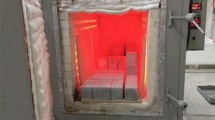Abstract
With a view to verifying the feasibility of evaluating early concrete strength, an extensive experimental program was developed for testing the strength of steam-cured 8 cm concrete cubes after 17 hours (R a ) and comparing the results with the strength of 15 cm cubes at 28 days (R s ). The relationship of R a to R s depends on the steam curing cycle, on the maximum aggregate size and its influence in relation to sample size, and on the rate of loading during the test. The R a -R s regression line was calculated for different concrete mixes using various types of cement (to Italian standards), i.e., Portland 325 and 425, pozzolana 325 with fly ash and Portland 325 with a superplasticizing admixture. A linear relationship generally proved reliable as R s =mR a +c, where m and c are constants depending on the type of cement, the curing cycle and the maximum aggregate size. The coefficient of variation was about 4–5%, reaching 6% when all concrete mixes tested were considered.
Resume
Ce vaste programme expérimental visait à connaître la résistance du béton le plus tôt possible après le bétonnage. En utilisant un traitement de maturation à la vapeur, on a établi un rapport entre la résistance d'un cube de 8 cm de côté, après 17 heures (Ra) et celle d'un cube de 15 cm de côté après 28 jours (Rs). Ce rapport dépend du cycle thermique, du diamètre maximum du gravier, et de son influence sur les dimensions des échantillons ainsi que de la rapidité d'exécution de l'essai. On donne la régression Ra-Rs pour différents types de béton en utilisant des ciments conformes aux normes italiennes: Portland 325 et 425, pozzolana 325 aux cendres volantes, Portland 325 avec un superplastifiant. Cette expérimentation prouve qu'il existe une relation linéaire Ra=mRa+c où m et c sont les deux constantes liées au type de ciment, au cycle thermique et à la dimension du gravier, avec un coefficient de variation de 4–5% environ et un maximum de 6%, en cas d'utilisation de toutes les valeurs trouvées.
Similar content being viewed by others
References
‘Eurocode 2, Design of concrete structures, Part 1: General rules and rules for building, October 1989’.
‘ISO Norm 2736/2, Making and curing of test specimens for strength tests’.
Siviero, E., ‘Early evaluation of concrete strength’, in Second International Symposium on Quality Control of Concrete Structures, CEB-RILEM, Ghent, June 12–14, 1991.
Price, W. H., ‘Factors influencing concrete strength’,Proc. Am. Concr. Inst. 47 (1951) 417–432.
Collepardi, M., ‘Scienza e Tecnologia del Calcestruzzo’ (Hoepli, Milano, Italy, 1991).
Neville, A. M., ‘Properties of Concrete’ (Pitman Publishing, London, 1975).
‘ENV 206, Concrete—Performance, production, placing and compliance criteria’.
Newman, K. and Lachance, L., ‘The testing of brittle materials under uniform uniaxial compressive stress’,Proc. ASTM 64 (1964) 1044–1067.
Neville, A. M., ‘Some aspects of the strength of concrete’,Civil Engng Public Workers Revue 54 Part 1 (1959) 1153–1156; Part 2 (1959) 1308–1310; Part 3 (1959) 1435–1439.
Bažant, Z. P.,ASCE Proc. J. Em-Divn 102 (1976) 331.
Tanigawa, Y. and Yamada, R., ‘Size effect in compressive strength of concrete’,Cem. Concr. Res. 8 (1976) 181–190.
Rüsch, H., ‘Stahlbeton-Spannbeton Werkstoffeigenshaften und Bemessung Verfahren’, Band 1 (Werner Verlag, Düsseldorf, Germany, 1972).
Walther, R. and Miehlbradt, M., ‘Dimensionnement des structures en béton’, ‘Traité de Génie Civil de l'Ecole Polytechnique Fédérale de Lausanne’, Vol. 7 (1990).
McHenry, D. and Shideler, J. J., ‘Review of data on effect of speed in mechanical testing of concrete’,ASTM STP 185 (1956).
Verbeck, G., ‘Cement hydration reactions at early stages’, Portland Cement Association Research Department, Bulletin 189, Skokie, IL, 1975.
Ravina, D., ‘Efficient utilization of coarse and fine fly ash in precast concrete by incorporating thermal curing’,ACI J. 78 (1981) 194–200.
Alexanderson, J., ‘Strength losses in heat cured concrete’, Swedish Cement and Concrete Research, Institute of Technology, Proc. No. 43, Stockholm, Sweden 1972.
King, J. W., ‘Further notes on the accelerated test for concrete’,Chartered Civil Engr No. 5 (1957) 15–19.
Dreux, G. and Gorisse, P., ‘Contribution à l'étude statistique des contrôles du béton. Mise au point d'un test accéléré’,Annales 302 (1973) 145–192.
Shah, G. B., ‘Estimation of compressive strength from accelerated strength tests’,Indian Concr. J. (March 1986) 75–78.
Chengju, G., ‘Some statistical points in predicting strength of concrete by empirical method’, in Second International Symposium on Quality Control of Concrete Structures, CEB-RILEM, Ghent, June 12–14, 1991.
Author information
Authors and Affiliations
Rights and permissions
About this article
Cite this article
Siviero, E. Evaluation of early concrete strength. Materials and Structures 27, 273–284 (1994). https://doi.org/10.1007/BF02473044
Issue Date:
DOI: https://doi.org/10.1007/BF02473044




